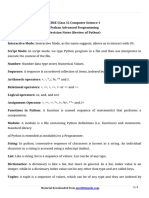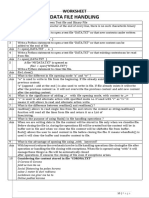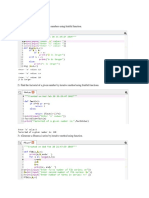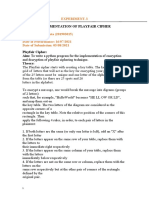0 ratings0% found this document useful (0 votes)
156 viewsFile Handling in Python
This document discusses file handling in Python through 4 code examples. The first example demonstrates opening and writing to a file. The second example opens a file in write and binary mode and displays file details. The third example writes encoded data to a file and then reads it back. The fourth example writes 3 lines to a file and confirms the write was successful.
Uploaded by
kpraj447Copyright
© © All Rights Reserved
We take content rights seriously. If you suspect this is your content, claim it here.
Available Formats
Download as DOCX, PDF, TXT or read online on Scribd
0 ratings0% found this document useful (0 votes)
156 viewsFile Handling in Python
This document discusses file handling in Python through 4 code examples. The first example demonstrates opening and writing to a file. The second example opens a file in write and binary mode and displays file details. The third example writes encoded data to a file and then reads it back. The fourth example writes 3 lines to a file and confirms the write was successful.
Uploaded by
kpraj447Copyright
© © All Rights Reserved
We take content rights seriously. If you suspect this is your content, claim it here.
Available Formats
Download as DOCX, PDF, TXT or read online on Scribd
You are on page 1/ 1
Program-06: File handling in python
#1 Python code to create and write in to a file
file = open('geek.txt','w')
file.write("This is the write command")
file.write(" It allows us to write in a particular file")
print("Successfully writing in to the file is completed")
file.close()
Output: Successfully completed
#2 Open a file in write and binary mode.
fob = open("app.log", "wb")
#Display file name.
print("File name: ", fob.name)
#Display state of the file.
print("File state: ", fob.closed)
#Print the opening mode.
print("Opening mode: ", fob.mode)
Output: File name: app.log
File state: False
Opening mode: wb
#3 Encoding the writing data in to the file
with open('app.log', 'w', encoding = 'utf-8') as f:
#first line
f.write('my first file\n')
#second line
f.write('This file\n')
#third line
f.write('contains three lines\n')
with open('app.log', 'r', encoding = 'utf-8') as f:
content = f.readlines()
for line in content:
print(line)
output: my first file
This file
contains three lines
#4 program for to check either writing in to the file r not
with open("test.txt",'w',encoding = 'utf-8') as f:
f.write("my first file\n")
f.write("This file\n\n")
f.write("contains three lines\n")
Output: Successfully write the three lines in to the files
You might also like
- Name - Grade - / 32: National 5 Computing Homework100% (1)Name - Grade - / 32: National 5 Computing Homework4 pages
- 12 Comp Sci 1 Revision Notes Pythan Advanced ProgNo ratings yet12 Comp Sci 1 Revision Notes Pythan Advanced Prog5 pages
- Introduction To Programming Using PythonNo ratings yetIntroduction To Programming Using Python11 pages
- Computer Science: Topic 2.2 - Programming TechniquesNo ratings yetComputer Science: Topic 2.2 - Programming Techniques5 pages
- File Handling MQP With Solutions by Nitin PaliwalNo ratings yetFile Handling MQP With Solutions by Nitin Paliwal12 pages
- Floating Point Representation Latest by MR SaemNo ratings yetFloating Point Representation Latest by MR Saem69 pages
- Write A Python Program To Check Whether The Given Number Is Positive or NegativeNo ratings yetWrite A Python Program To Check Whether The Given Number Is Positive or Negative6 pages
- String Manipulation: Introduction To Programming: PythonNo ratings yetString Manipulation: Introduction To Programming: Python2 pages
- Python Practical No.3 While Loop ProgramsNo ratings yetPython Practical No.3 While Loop Programs7 pages
- Python Revision Material - CH.1,2.3.5.9No ratings yetPython Revision Material - CH.1,2.3.5.931 pages
- Python Regular Expression - Exercises, Practice, Solution - W3resource12No ratings yetPython Regular Expression - Exercises, Practice, Solution - W3resource121 page
- Finding Square Root by Newton's Iteration - An Introduction To Python and LaTeXNo ratings yetFinding Square Root by Newton's Iteration - An Introduction To Python and LaTeX4 pages
- Implementation of Playfair Cipher: Experiment-3No ratings yetImplementation of Playfair Cipher: Experiment-35 pages



























































